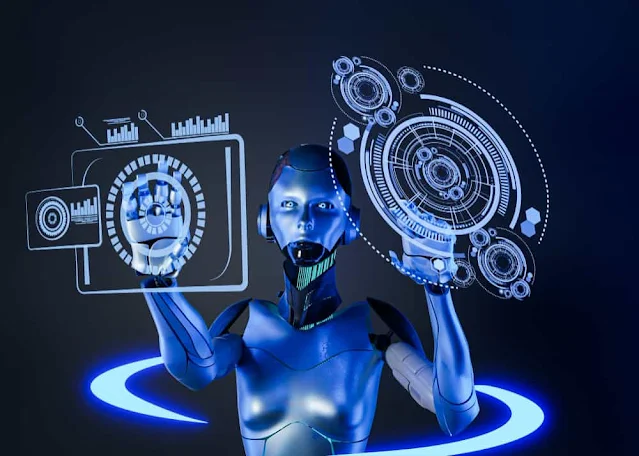The realm of artificial intelligence (AI) has captured the imagination for decades, with visions of robots taking over the world or benevolent machines guiding us toward a utopian future. Today, AI is no longer confined to science fiction. It has infiltrated our daily lives, quietly shaping everything from the personal recommendations we receive online to the fabric of modern industries.
As AI continues to rapidly evolve, understanding its essence and diverse forms is becoming increasingly important. This comprehensive guide seeks to demystify AI, offering a deep dive into its fundamental concepts, applications, and potential impact on the future.
Delving into the Core: Understanding the Essence of AI
At its heart, AI represents the quest to create intelligent machines capable of mimicking, and even surpassing, human cognitive abilities. It encompasses a spectrum of functionalities, including learning, reasoning, problem-solving, decision-making, and even creativity. Unlike traditional computer programs, which rely on pre-programmed instructions, AI systems can learn and adapt autonomously, developing their capabilities based on data and experience.
The Power of Machine Learning: A Catalyst for Automation and Insights
Machine learning, a subfield of AI, lies at the core of this learning process. By leveraging sophisticated algorithms and vast data sets, machine learning models can identify patterns, make predictions, and automate tasks with remarkable accuracy. From facial recognition systems that identify individuals in real-time to algorithms that predict consumer behavior with uncanny precision, machine learning's applications are revolutionizing diverse sectors.
Unlocking the Potential: Exploring the Diverse Forms of AI
The landscape of AI is rich and multifaceted, encompassing a multitude of specialized fields, each with unique capabilities and applications. Let's embark on a journey to explore some of the most prominent forms of AI:
1. Natural Language Processing (NLP): Bridging the Gap between Humans and Machines
Imagine a machine capable of understanding and responding to human language with the fluency and nuance of a seasoned conversationalist. NLP strives to make this vision a reality. This field focuses on enabling computers to comprehend and process human language, allowing for seamless communication and interaction. NLP powers virtual assistants like Siri and Alexa, facilitates machine translation, and drives the development of chatbots that can offer personalized assistance in diverse settings.
2. Computer Vision: Unveiling the World Through Artificial Eyes
Imagine a computer possessing the remarkable ability to interpret and analyze visual information as effortlessly as we humans do. Computer vision, another major branch of AI, makes this possible. By leveraging algorithms and deep learning techniques, computers can now "see" and understand the world around them, recognizing objects, analyzing scenes, and even navigating complex environments. This has led to numerous applications, including automated image and video analysis, self-driving cars, and sophisticated surveillance systems.
3. Robotics: Blurring the Lines between Machine and Human
The realm of robotics focuses on designing, building, and programming robots capable of performing a range of tasks, from automating tedious industrial processes to assisting in complex surgical procedures. As AI advancements continue to enhance robotic capabilities, the line between machine and human becomes increasingly blurred. Collaborative robots, or cobots, are now working alongside humans in factories, while advancements in exoskeleton technology are empowering individuals with disabilities to perform tasks previously considered impossible.
4. Deep Learning: Mimicking the Human Brain for Enhanced Intelligence
Deep learning, a subfield of machine learning, is inspired by the human brain's structure and function. It utilizes artificial neural networks, intricate systems of interconnected nodes, to learn from vast amounts of data and extract complex patterns. This powerful technique has revolutionized AI capabilities, enabling machines to excel at tasks that were once considered exclusive to human intelligence, such as image recognition and natural language processing.5. Explainable AI (XAI): Demystifying the "Black Box" of AI Decisions
As AI models become increasingly complex, concerns regarding their decision-making processes arise. XAI aims to address this challenge by providing transparency and understanding into the inner workings of AI systems. By deconstructing complex algorithms and translating them into human-interpretable formats, XAI strives to build trust and ensure responsible development and deployment of AI technologies.The Future Beckons: AI's Potential Impact on Our World
The rise of AI presents a multitude of opportunities for progress across diverse sectors. From tackling climate change and improving healthcare to revolutionizing industries and enhancing our understanding of the universe, AI's potential to transform our world is monumental. However, with great power comes great responsibility. As AI continues to evolve, ensuring its ethical development and deployment is paramount. Addressing concerns regarding job displacement, data privacy, and potential misuse of AI requires a collaborative effort from researchers, developers, policymakers, and the public alike.Embracing the AI Revolution: Preparing for a Transformed World
- Cultivate a Growth Mindset: Embrace continuous learning and upskilling to adapt to the evolving job market. Discover online courses, attend workshops, and gain new skills related to an AI-powered future.
- Develop digital literacy: Equip yourself with a solid understanding of AI concepts, applications, and potential risks. Develop critical thinking skills to evaluate information and discern truth from misinformation.
- Advocate for Responsible AI Development: Support initiatives that promote the development and deployment of ethical AI. Engage in public discourse and hold governments and corporations accountable for responsible AI practices.
- Foster collaboration: bridge the gap between diverse disciplines by fostering collaboration between researchers, developers, policy makers and the public. This collective effort is critical to ensuring the inclusive and beneficial development of AI.
- Foster creativity and innovation: AI can be a powerful tool for enhancing human creativity and intelligence. Encourage individuals to explore and leverage AI technologies to solve problems, generate new ideas and contribute to advancements in various fields.



